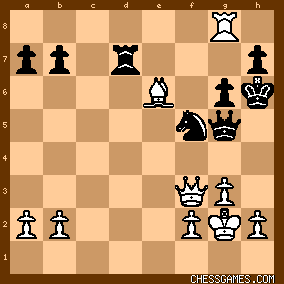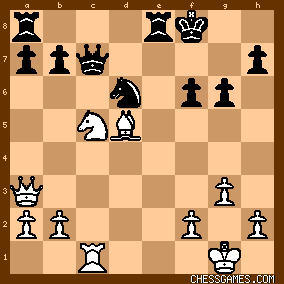| Jul-08-08 | | think: Unfortunately for Ivkov, there isn't much better than gobbling the rook: 29. ... Re8 is even worse due to 30. Qxd6+. The threat of Ne6 is just too much. |
|
| Jul-08-08 | | grasser: Where is the forced win? |
|
| Jul-08-08 | | arsen387: seems like the win is 38.Bxf5 removing the key defender after which black K is widely exposed, e.g 37..Rd4 38.Bxf5 gxf5 39.Qxf5 and after a few checks by black whites win |
|
| Jul-08-08 | | JohnTal: Except for 37 ... Rg7, Portisch would simplify the ending with 38 Bf5 .. gf, 39 Qf5 leaves Lajos with a 2P advantage on the K-side -- along with his R cutting off any retreat along the g-file. If 37... Rg7, I suspect Lajos would have exchanged rooks then done moves 38-39 that I have referenced - leaving him up 2P's on the K-side. He would allow Boris a harmless + (39 .. Qc1+), but I suspect that both players knew that Lajos could easily convert a K-side pawn majority into a W -- furthermore, with sound play, LP's Q is more active and could keep threats up against Black's a,b and h pawns while being able to hide his K against any perpetual check efforts from Borislav. |
|
| Jul-08-08 | | Amarande: Also if -
* 37 ... Re7 38 Bxf5 and Black does *not* have any drawing resources, despite the fact that there are a couple of White pitfalls, e.g. - 38 ... gxf5 39 Qg2?? (plan: Qh3 mate) Re1+! 
38 ... gxf5 39 Qxf5 Re1+ 40 Kg2 Qc6+ 41 Qf3?? Rg1+!  38 ... gxf5 39 Qxf5 Re1+ 40 Kg2 Qc6+ 41 f3! Re2+ 42 Kh3! and all Black checks are covered (there being no chance for a perpetual by Rxh2+ etc. either, since White's Queen prevents Qc2+). * 37 ... Qc1+ 38 Kg2 Rd1 looks dangerous, but after 39 Bxf5 Rg1+ 40 Kh3 Qf1+ 41 Kh4! White's King is safe and Black even does not get to recover his piece in addition to all his woes - if 41 ... gxf5 42 Qf4 mate, and the seemingly dangerous fork 41 ... Qc4+ fails to 42 Qf4+ Qxf4+ 43 gxf4 and Black's g-pawn finds itself quite elegantly pinned. Finally if 41 ... g5+ 42 Rxg5, and Black must still exchange Queens: 42 ... Qc4+ (only way to stop 43 Qh5 mate) 43 Qf4! and Black must exchange queens (otherwise 44 Rg6, a pretty double check and mate). |
|
| Jul-08-08 | | kellmano: I have seen a lot of Ivkov games but i don't think i've yet seen one that he has won. I guess he was a quality player due to his opposition in said games. Maybe people will be saying the same about Van Wely in 30 years time. |
|
| Jul-08-08 | | Morten: Resignation seems a bit premature, but I probably did not see everything. 37.-,Rg7.38.Rxg7,Nxg7.39.Qe3+,g5.40.h4,Qe7.41.hx-
g5+ and general exchange on g5 looks like a win for white, the bishop being stronger than the knight when there is play on both wings and the a-pawn promoting on a white square. But with the black king in a much more active position there could be some play left. Maybe white should avoid exchanges and keep the black king on the rim. 40.Bg8 could be strong and if so the whole Nxg7 defence may be no good. |
|
| Jul-08-08 | | RandomVisitor: 23...Bb5 and 24...Rac8 were possible improvements over the moves actually played. 29.Nc5 wins faster, aiming for the e6 fork square. |
|
| Jul-08-08 | | ge1144: I agree with RandomVisitor. The point is, and this important for average rated players, is that Nf3,eg/ KIA/Reti/Catalan, etc is only for accomlished positional players. My countryman Ulf Andersson has made his mark using such openings as white. I, being less accomplished, have had poorer results. Thank you Portisch for showing the value of transitional sequences, again. The value of misleading pragmatists is invaluable. |
|
| Jul-08-08 | | kevin86: The end will come-but later than sooner. It looks like white will gain a pawn or two and black will have the grim choice of exchanging pieces or allow a quick mate. |
|
| Jul-08-08 | | AAAAron: I don't understand this title... |
|
| Jul-08-08 | | kkshethin: <Amarande: Also if -
* 37 ... Re7 38 Bxf5 and Black does *not* have any drawing resources, despite the fact that there are a couple of White pitfalls, e.g. - 38 ... gxf5 39 Qg2?? (plan: Qh3 mate) Re1+!
38 ... gxf5 39 Qxf5 Re1+ 40 Kg2 Qc6+ 41 Qf3?? Rg1+!
38 ... gxf5 39 Qxf5 Re1+ 40 Kg2 Qc6+ 41 f3! Re2+ 42 Kh3! and all Black checks are covered>
I think there is some error in your reasoning. After 42 Kh3 43 Q c1+ and it is mate by black |
|
| Jul-08-08 | | patzer2: Maybe White wins with near perfect play, but after 37...Qc1+ 38. Kg2 Qg5! (diagram below) Black can put up a defense with some practical chances. 
click for larger view(39.? White to play from analysis)
Note that here 39. Bxd7?? drops the Queen to 39...Nh4  +. So one likely continuation might be 39. Bxf5 Qxf5 40.
Qe3+ with a clear but not necessarily decisive advantage. +. So one likely continuation might be 39. Bxf5 Qxf5 40.
Qe3+ with a clear but not necessarily decisive advantage. |
|
| Jul-08-08 | | patzer2: With the positional sacrifice 29. Nf4!, White temporarily gives up the exchange for a strong and near decisive positional attacking advantage against the resulting weakened Black King position. |
|
| Jul-08-08 | | actinia: conceivably black lost on time |
|
| Jul-08-08 | | Marmot PFL: Black lost on time in what Istvan Csom (Portisch's fellow Hungarian) says is a winning position. This depends on white being able to win the rook ending above, which as Patzer says is likely but not a sure thing. The annotator questioned 16...Nf5 and recommended Qb6 instead. |
|
Jul-08-08
 | | Honza Cervenka: 29.Nc5 was more precise as then after 29...Bxd5 30.Bxd5 Re8 white can play 31.Rc1 with threats 32.Ne6+ or 32.Nxb7 after some retreats of Queen. |
|
| Jul-08-08 | | zb2cr: <AAAAron>,
It's a play on words in colloquial English. A statement that is impossible to understand is sometimes called "gobbledygook". Thus, change one letter and it's "gobbledyrook". |
|
| Jul-08-08 | | Amarande: <kkshethin> If 37 ... Re7 38 Bxf5 gxf5 39 Qxf5 Re1+ 40 Kg2 Qc6+ 41 f3 Re2+ 42 Kh3 Qc1, as you suggest (which isn't even a check), then White mates simply by 43 Qf6+ Kh5 44 Qh4. If here 38 ... Re1+ 39 Kg2 Qc1, White can simply withdraw the Bishop with an easy win; as in the variation where Black tries 37 ... Qc1+ at once, White's Rook is in no danger because after 40 Bc8 Rg1+ 41 Kh3 Qf1+ 42 Kh4 Qc4+ (seemingly winning the Rook) 43 Qf4 CHECK breaks the fork and forces the exchange of Queens, leaving White with a piece up and an easy win. |
|
| Jul-08-08 | | RandomVisitor: <Marmot PFL: The annotator questioned 16...Nf5 and recommended Qb6 instead.>
1: Lajos Portisch - Borislav Ivkov, Petropolis 09 1973

click for larger viewAnalysis by Rybka 2.3.2a mp : <21-ply> 1. (0.45): 16...Nf5 17.Rac1 h6 18.Bxf6 Bxf6 19.Qa4 h5 20.e4 dxe4 21.Nxe4 Bg7 22.f4 Re7 23.Qa3 2. (0.57): 16...Nfe4 17.Bxe7 Qxe7 18.Bxe4 Nxe4 19.Rac1 Nd6 20.Nb5 Nxb5 21.Qxb5 f6 22.Nd3 Qd8 23.Rc2 3. (0.57): 16...Nde4 17.Bxe4 Nxe4 18.Bxe7 Qxe7 19.Rac1 Nd6 20.Nb5 Nxb5 21.Qxb5 f6 22.Nd3 Qd8 23.Rc2 |
|
| Jul-08-08 | | patzer2: <Honza Cervenka> Good catch on 29. Nc5!! being the stronger and quicker winning alternative. After the forced sequence 29. Nc5!! Bxd5 30. Bxd5 Re8 31. Rc1!, White's multiple threats overwhelm Black's exposed Queen and helpless King position (diagram below).
click for larger view[From analysis, 31...? Black to move]
White wins quickly in all variations. For example, Black can resign after 31...Qe7 (31...Qg7 32. Nxb7  ; 31... Ke7 32. Qe3+ Kd8 33. Qd2! ; 31... Ke7 32. Qe3+ Kd8 33. Qd2!  ) 32. Ne6+ Kg8 33. Rc7 ) 32. Ne6+ Kg8 33. Rc7  . . |
|
| Jul-08-08 | | lebourdonant: Is white best move after 37..Rg7 to take the rock ?! 38 RxR KxR or can't white play a rock move like 38 Rf8 or a tempo with Rc8 (also prevent queen check) ,
with the black rock on g7 the motion of black king is limited,
and with both move the knight is still threatened. |
|
| Jul-09-08 | | patzer2: <lebourdonant> After 37...Rg7, perhaps best is 38. Rf8!, keeping the pressure on Black's exposed King position. Here's some computer-checked possibilities:
<37... Rg7> 38. Rf8! Nd4 (38... Qc5 39. Qf4+ g5 40. Qxf5  ; 38... Qc1+ 39. Kg2 Ne7 40. Rf4 g5 41. Rc4 Qe1 42. Re4 Qa5 43. Qf6+ Ng6 44. h4 Re7 45. hxg5+ Qxg5 46. Rh4+ ; 38... Qc1+ 39. Kg2 Ne7 40. Rf4 g5 41. Rc4 Qe1 42. Re4 Qa5 43. Qf6+ Ng6 44. h4 Re7 45. hxg5+ Qxg5 46. Rh4+  ; 38...Qc6 39. Qf4+ Kh5 40. Bxf5 gxf5 41. Rxf5+ Kg6 42. Qg5#) 39. Qe3+ g5 40. Qxd4 ; 38...Qc6 39. Qf4+ Kh5 40. Bxf5 gxf5 41. Rxf5+ Kg6 42. Qg5#) 39. Qe3+ g5 40. Qxd4  . . |
|
| Jul-09-08 | | paul1959: <RandomVisitor> Black had two additional interesting alternatives at move 23: 23 ... Nf5 and 23...f6. Looks like 23...Be8 was worst |
|





